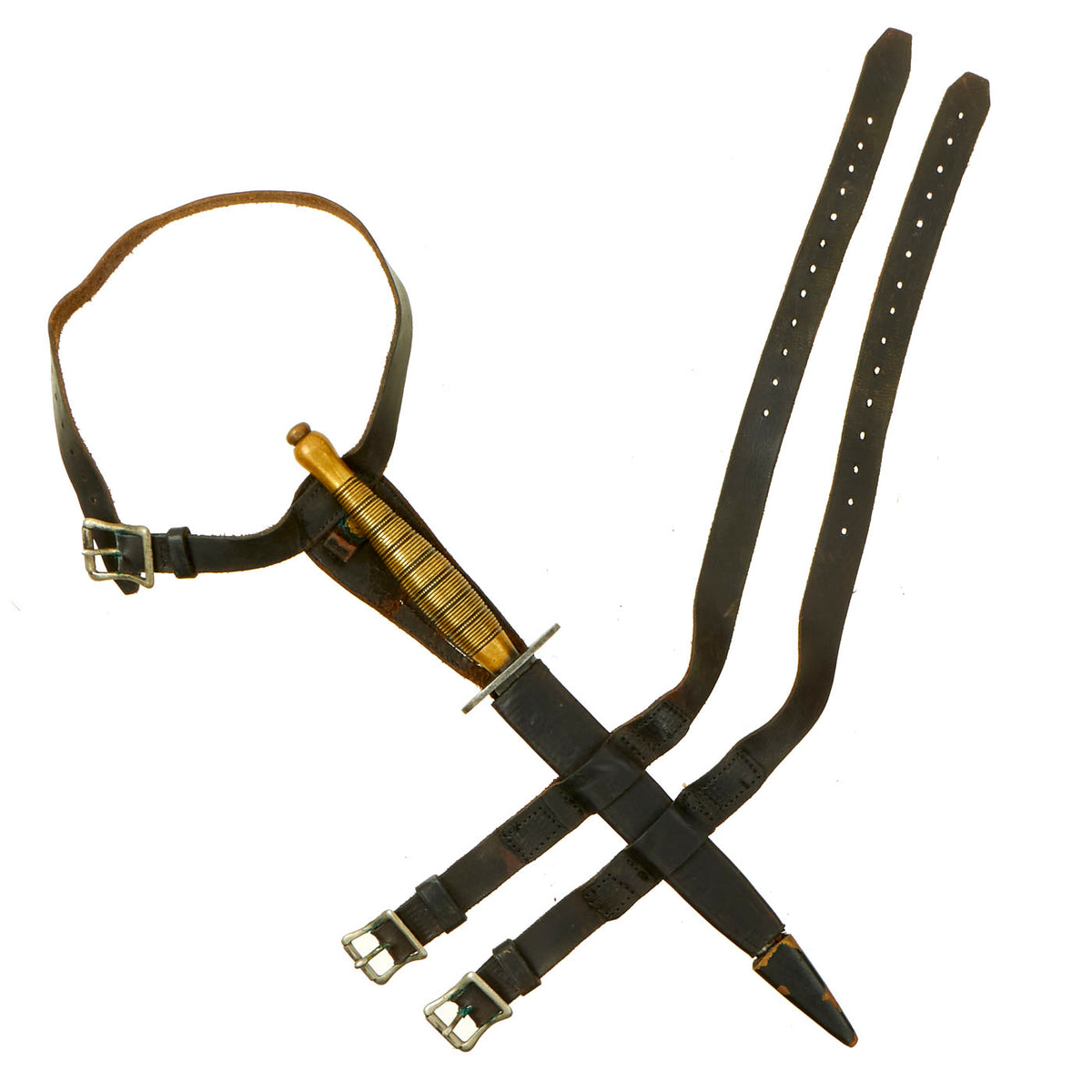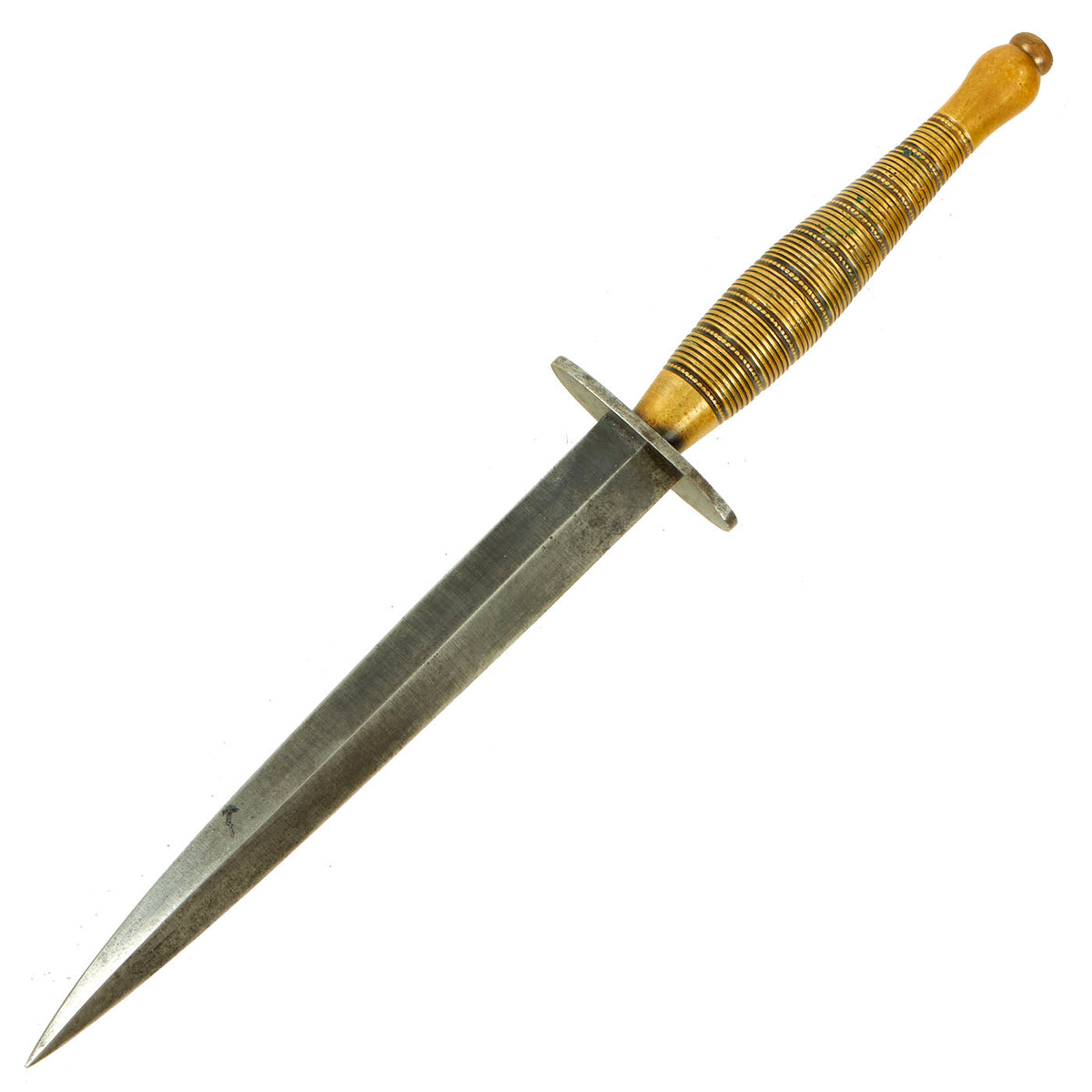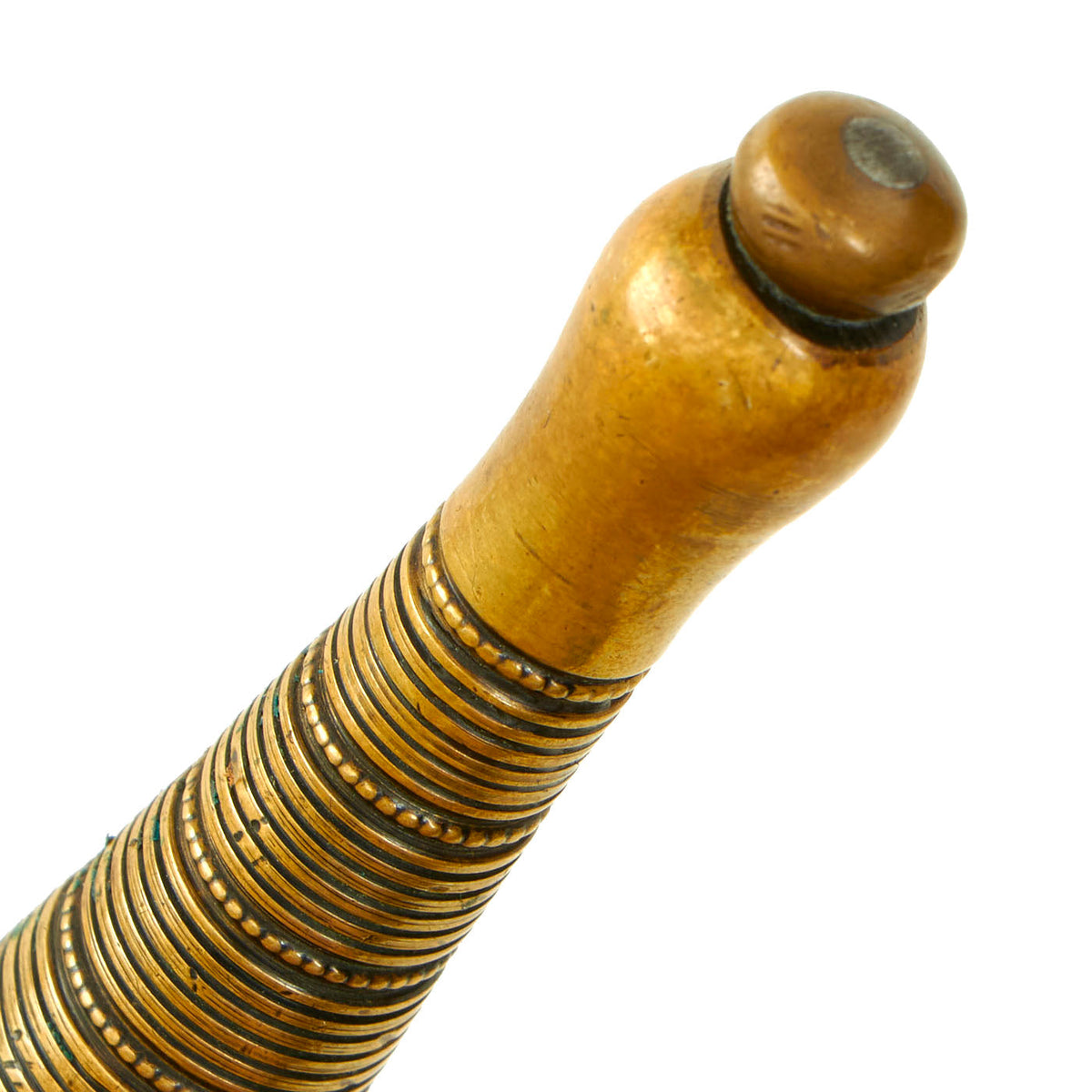Original British WWII Rare “Beaded and Ribbed” Fairbairn Sykes Second Pattern Commando Knife With Lower Leg Concealed Carry Scabbard Rig Original Items
$ 1.295,00 $ 323,75
Original Items: Only One Available. This is one of the rarer and most elegant 2nd Pattern Fairbairn Sykes knives with the lovely “Beaded and Ribbed” brass handle. If you thought this knife couldn’t get any better, it comes with another rather rare item, a lower leg scabbard rig for either concealed carry or open carry. This is a killer pair of items!
This variant of the Fairbairn Sykes Fighting Knife was given this name due to the ornately designed grip which has a series of ribs interspersed with 9 rings of beads. The reason for this was to add a more secure grip when the knife was being utilized. This Ribbed & Beaded F-S Knife can be found with many subtle variations, manufactures anomalies and inspection marks and can be a study in its own right. This example is completely sanitized and does not have any markings, not even a casting number can be found. This would have been perfect for the clandestine operator.
The changes made to the original First Pattern F-S knife design by Wilkinson Sword in August of 1941 resulted in what is now referred to as the Second Pattern. Those modifications were in response to an increased demand on production and a need to ‘speed up’ the manufacturing process. The most notable changes to the knife’s design were the loss of the blade tablet ricasso and the replacement of the ‘S’ shaped crossguard with one that was straight. This resulted in a design of more symmetry and a visually sleeker profile which importantly achieved its intended goal of facilitating faster production without affecting the basic design or quality. These changes resulted in what collectors now recognize as the classic Second Pattern F-S knife design.
Condition of the knife is very good, still with sharp edges. Blade tip is excellent, and overall very good with some original black still present on the blade and in the recesses of the brass grip handle.
The leg rig sheath is in good condition but unfortunately the lower brass chape is completely detached from the scabbard and the leather securing strap is completely missing from the tongue at the top. The leg straps are in great condition and still secured perfectly to the leather tabs on the sides. The belt loop tongue at the top shows signs of extensive wear and does have cracking present in the finish.
This is truly a fantastic pair of items, perfect for the commando displays!
Dimensions:
Blade length: 7 ¾”
Blade Style: Spear Point Knife
Overall length: 11 ¾”
Crossguard: 2”
Scabbard length: 7 ⅞” with belt loop (measured with the chape “attached”)
History of the Fairbairn-Sykes British commando dagger:
The demand for a good fighting knife was so very urgent that a meeting was arranged in November 1940 between W. E. Fairbairn, E. A. Sykes and Jack Wilkinson Latham at Wilkinson Sword Company. Fairbairn and Sykes described the type of knife they envisioned and the purpose for which it was intended. As discussion continued, preliminary sketches were drawn up and modified time and time again.
As Robert Wilkinson Latham tells it:
‘In order to explain exactly their point, the two men rose to their feet and one, it was Fairbairn my grandfather mentioned, grabbed the wood ruler from his desk and the two men danced around the office in mock combat’.
The very first 1st Pattern F-S Fighting Knives were made in November 1940. In January 1941the full war full production started, according to Robert Wilkinson Latham. The grip was made from solid brass and cut by 16 lines per inch in a diamond pattern. The grip and hand guard were nickel plated. The hand guard was curved to S-shape. The blade was grounded by hand. For this reason it is difficult to find two blades of exactly the same size and shape. This model was produced in very limited numbers.
The very first 1st Pattern Wilkinson Sword F-S knives were ordered the 14th of November 1940. Order 294 mentions 500 ‘RBD and Commercial knives’ but possibly less. They were called in this way in the order to disguise the actual type of knife. The 1st Pattern was delivered from November 1940 until April 1941. 17th of December 1940 5000 “hunting knives” were ordered. This order concerned the first 1st Pattern knives. Price for each was 13 s 6d. All together 6,779 – 1st pattern were made.
However, as wartime demand increased, it was necessary to simplify and speed up production. Furthermore strategically important materials like brass were now in short supply. This meant that crucial changes were made to the knife design, resulting in the “Second Pattern” commando dagger, produced from August 1941 until October 1943.
While the handle design remained the same, it was cast with a hollow core meaning that it could be made using less brass. The s-shaped guard was replaced by a simpler flat design and the flat ricasso was removed from the base of the blade, enabling a more straight forward grind which could be done by machine. The scabbard’s press-stud was replaced by an elastic retaining strap. It is important to note that as there was no official specification to cover the knife, many subtle variations from the period can be seen. In September 1942, the bright finish was replaced by the now more familiar blacked knife. The scabbard chape was also blacked to help prevent the metal from reflecting light.
In October 1943, to further expedite production, further changes to the design were made, which resulted in the “Third Pattern”, which is in production to this day. The dagger was being made at a number of different companies, many based in the Sheffield area, and these changes were mainly motivated from their end, not the field end. Most manufacturers now favored a fully machine ground blade, such that the central grinding line ran the complete length of the blade. The checkered knurled handle was replaced by one with 27 concentric rings to aid grip, thought to be the idea of Joseph Rodgers of Sheffield. The brass handle material was then replaced with a non-strategic alloy as production continued. The new handle was easier to cast and would have been requiring little or no remedial work.
Fast Shipping with Professional Packaging
Thanks to our longstanding association with UPS FedEx DHL, and other major international carriers, we are able to provide a range of shipping options. Our warehouse staff is expertly trained and will wrap your products according to our exact and precise specifications. Prior to shipping, your goods will be thoroughly examined and securely secured. We ship to thousands clients each day across multiple countries. This shows how we're dedicated to be the largest retailer on the internet. Warehouses and distribution centres can be located throughout Europe as well as the USA.
Note: Orders with more than one item will be assigned a processing date depending on the item.
Before shipping before shipping, we'll conduct a thorough inspection of the items you have ordered. Today, the majority of orders will be delivered within 48 hours. The delivery time will be between 3-7 days.
Returns
The stock is dynamic and we cannot completely manage it because multiple stakeholders are involved, including our factory and warehouse. So the actual stock may alter at any time. It's possible that you may not receive your order once the order has been made.
Our policy is valid for a period of 30 days. If you don't receive the product within 30 days, we are not able to issue a refund or an exchange.
You can only return an item if it is unused and in the same state as the day you received it. You must have the item in its original packaging.
Related products
Uncategorized
Angolan Rebel 1970s era 60mm Inert Display Mortar from Angolan Civil War Original Items
Uncategorized
Armored Burgonet Helmet & Polearm from Scottish Castle Leith Hall Circa 1700 Original Items
Uncategorized
Uncategorized
Uncategorized
Uncategorized
Uncategorized
Band of Brothers ORIGINAL GERMAN WWII Le. F.H. 18 10.5cm ARTILLERY PIECE Original Items
Uncategorized
Uncategorized
Uncategorized
Uncategorized
Uncategorized
Uncategorized
Uncategorized
Uncategorized
Uncategorized













































































